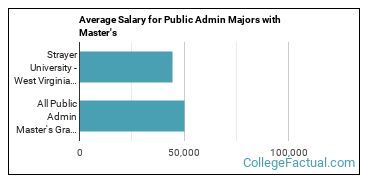 by our College Data Analytics Team
by our College Data Analytics TeamPublic Administration is a major offered under the public administration and social service program of study at Strayer University - West Virginia. We’ve pulled together some essential information you should know about the master’s degree program in public admin, including how many students graduate each year, the ethnic diversity of these students, and more.
You can jump to any section of this page using the links below:
In 2019-2020, the average part-time graduate tuition at Strayer University - West Virginia was $553 per credit hour for both in-state and out-of-state students. The average full-time tuition and fees for graduate students are shown in the table below.
| In State | Out of State | |
|---|---|---|
| Tuition | $14,940 | $14,940 |
| Fees | $195 | $195 |
The median early career salary of public admin students who receive their master’s degree from Strayer University - West Virginia is $42,682 per year. That is 15% lower than the national average of $50,200.

Looking for online learning options? Good news, you can take online classes in the public admin master’s degree program at Strayer University - West Virginia. To see if the school offers distance learning options in other areas, visit the Strayer University - West Virginia Online Learning page.
*The racial-ethnic minorities count is calculated by taking the total number of students and subtracting white students, international students, and students whose race/ethnicity was unknown. This number is then divided by the total number of students at the school to obtain the racial-ethnic minorities percentage.
More about our data sources and methodologies.